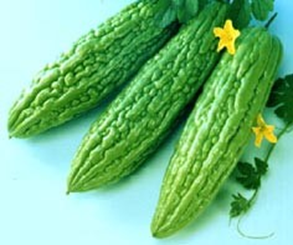By Dr. Manny C. Palada with (L.C. Chang)

Bitter gourd is well-liked in Southeast Asia for its uniquely-flavored fruits and tender vine tips.
Bitter gourd (Momordica charantia / Margoso in local term)) is one of the most popular vegetables in Southeast Asia. It is a member of the cucurbit family along with cucumber, squash, watermelon, and muskmelon. Native to China or India, the fast-growing vine is grown throughout Asia and is becoming popular worldwide. Depending on location, bitter gourd is also known as bitter melon, karella, or balsam pear.
The immature fruits and tender vine tips are used in a variety of culinary preparations. The fruits and shoots are soaked in salt water to remove some of their bitterness and then boiled, fried or pickled.
The fruit of bitter gourd fruit is similar in nutritional value compared to other cucurbits, with the notable exceptions that it is much higher in folate and vitamin C. The vine tips are an excellent source of vitamin A. The medicinal value of the gourd in the treatment of infectious diseases and diabetes is attracting the attention of scientists worldwide.
The following suggested cultural practices were developed at AVRDC in the Taiwan lowlands. Growers may need to modify the practices to suit local soil, weather, pest, and disease conditions.
- Bitter gourd grows well under the same conditions preferred by other cucurbits. It is normally grown as an annual crop, but can perform as a perennial.
- Numerous hybrid and open-pollinated varieties are available. Hybrids usually produce higher yields, but their seeds are relatively expensive and must be purchased for every planting. Open-pollinated varieties have the advantage that their seeds may be saved and used for future plantings.
- Thorough land preparation and a well-prepared bed is required. Plow, harrow and rototill the field. Form 20cm-high beds during the dry season and 30 cm or higher during the wet season using a plow or mechanical bed shaper (Thorough land preparation and a well-prepared bed is required. Plow, harrow and rototill the field. Form 20cm-high beds during the dry season and 30 cm or higher during the wet season using a plow or mechanical bed shaper
- Direct seeding is the most common method of planting. In cooler climates, it may be necessary to start the seedlings in a greenhouse to ensure good germination.
- Sow seeds should be placed in small plastic pots or containers using a potting mix that has good water-holding capacity and good drainage such as peat moss, commercial potting soil, or a potting mix prepared from soil, compost, rice hull, and vermiculite or sand. Plant two or three seeds per container and thin to a single seedling when they have four to six true leaves. Water the seedlings thoroughly every morning to maintain a moist but not wet soil.
- Bitter gourd grows very fast and vines elongate rapidly within two weeks after planting. Thereafter, the plant sends out lateral stems. Staking and trellising will increase fruit yield and size, reduce fruit rot, and make spraying and harvesting easier.
CPU College of Agriculture, Resources and Environmental Sciences is now recognized globally for its Vegetable R&D projects. Thanks to Dr. Palada as Convener representing CPU – one of the organizing institutions of the First International Symposium on Moringa (Balunggay or Malunggay).
